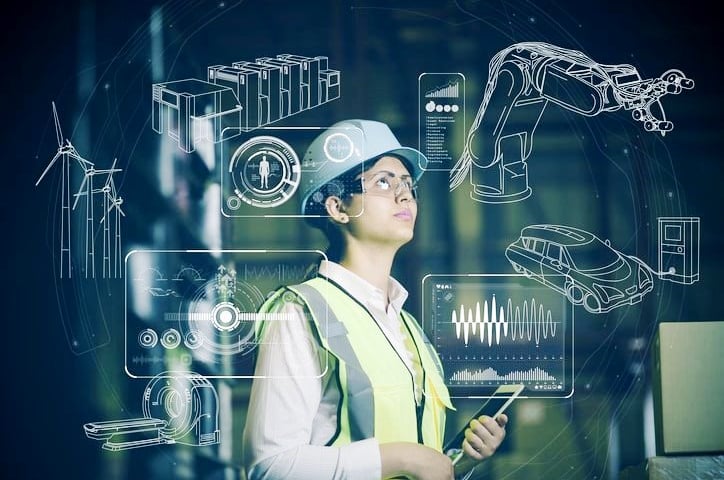🕵️♂️Cyber Week Special – Unbeatable deals across all products!🚀
The Power of Virtual Models in Shaping Our Physical World
Discover the impact of advanced virtual models, known as digital twins, on industries such as manufacturing and healthcare. Explore how these simulations enable predictive maintenance, improve decision-making processes, and envision the future of digital twins in reshaping our world
EVOLVING TECH
Phillemon Neluvhalani
5/8/20243 min read


Picture this: A digital clone that mimics every aspect of a physical object, system, or process, offering a sandbox for trial and error without any real-world risks or costs. That’s what digital twins offer. They're not just a futuristic concept but a present-day tool that is reshaping industries by allowing for detailed predictions and proactive optimizations.
Understanding Digital Twins
A digital twin is essentially a highly detailed virtual model that mirrors a physical object or system. It incorporates real-time data to stay up-to-date with its physical counterpart, facilitated by advancements in IoT, AI, and machine learning. These models enable users to simulate, predict, and optimize systems and processes in ways that were unimaginable just a few decades ago.
Applications Across Diverse Industries
Digital twins have a broad spectrum of applications across various sectors, illustrating their versatility and impact:
Manufacturing: In this sector, digital twins streamline production lines and predict maintenance needs, reducing downtime and increasing efficiency. By simulating production processes in a virtual environment, manufacturers can experiment with changes in a cost-effective manner.
Automotive: Car manufacturers utilize digital twins for everything from designing to testing new vehicle models under simulated conditions. This not only saves substantial resources but also enhances the safety features, fuel efficiency, and overall design of the vehicles.
Healthcare: In healthcare, digital twins offer revolutionary changes, from personalizing patient treatment plans to simulating complex surgical procedures. They also help in the design and operation of medical devices, predicting malfunctions before they become critical.
Urban Planning and Smart Cities: Cities use digital twins to optimize everything from traffic flows to energy consumption, improving urban living conditions and reducing environmental impact.
Energy: Whether it’s optimizing power plant operations or integrating renewable energy sources into the grid, digital twins provide energy companies with the tools to manage resources more efficiently and sustainably.
Predictive Maintenance with Digital Twins
One of the most valuable applications of digital twins is in predictive maintenance. These virtual models help anticipate equipment failures and schedule maintenance that prevents unexpected downtime, which can be incredibly costly. By continuously updating with real-time data, digital twins can alert operators about wear and tear, operational inefficiencies, or potential breakdowns before they occur.
Challenges and Considerations
Implementing digital twins isn't without its challenges:
- High Initial Costs: Setting up digital twins requires significant investment in technology and expertise, including advanced sensors and data processing capabilities.
- Complexity of Creation: Developing these sophisticated models demands a blend of skills across data science, software development, and the specific industry’s operational knowledge.
- Data Security and Privacy: With digital twins often processing large amounts of sensitive data, securing this information and ensuring compliance with data protection regulations is crucial.
The Future Landscape of Digital Twins
The trajectory for digital twins is set towards even greater integration and sophistication. Here are some potential future developments:
Consumer Applications: Beyond industrial applications, digital twins could become a part of everyday life, helping individuals optimize everything from personal health and fitness to home energy use.
Environmental Management: Digital twins could play a critical role in environmental conservation, helping model and mitigate the effects of climate change on natural and built environments.
Enhanced Connectivity: As IoT devices become more ubiquitous, the data available for digital twins will exponentially increase, improving their accuracy and functionality.
Ethical and Social Implications
As with any technology that can deeply integrate into personal and professional spaces, digital twins raise ethical and social concerns that need to be addressed:
Privacy: How do we ensure that data used in digital twins, especially in personal applications, is handled respectfully and ethically?
Access and Equity: There's a risk that the benefits of digital twins could be unevenly distributed, favoring those who can afford the investment in technology. Ensuring equitable access will be a significant challenge as these tools become more critical.
Digital twins are transforming how we interact with and manage the physical world, providing a bridge between virtual simulations and real-world applications. They offer unprecedented opportunities for prediction, optimization, and innovation, making them a cornerstone technology in numerous industries. As we look to the future, the role of digital twins is only set to grow, promising not just to adapt to our world but to actively shape it for the better.


